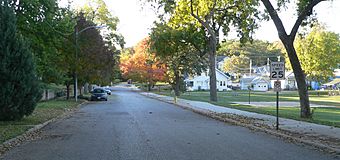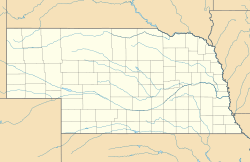Boulevards in Omaha, Nebraska facts for kids
Quick facts for kids |
|
|
Omaha Park and Boulevard System
|
|

Turner Boulevard south of Leavenworth Street. Leavenworth Park is at right.
|
|
| Location | Omaha, Nebraska |
|---|---|
| NRHP reference No. | 13000196 |
| Added to NRHP | April 23, 2013 |
Boulevards in Omaha, Nebraska are special, tree-lined streets. They are part of a big plan for parks and roads. This plan was first thought up in 1889 by a person named Horace Cleveland. Today, Omaha has over 100 miles (160 km) of these beautiful boulevards! This whole system of parks and boulevards is so important that it's listed on the National Register of Historic Places.
Contents
History of Omaha's Boulevards
In 1889, Horace W.S. Cleveland suggested that Omaha should build "broad ornamental avenues." These would be known as boulevards or parkways. He imagined them with pretty trees and bushes along the sides and in the middle. This idea was like the big city plans in Europe from the mid-1800s.
Early Boulevard Development
Omaha's Parks Commission liked Cleveland's plan. So, they started building Florence Boulevard in 1892. People called it "Omaha's Prettiest Mile Boulevard." In the early 1900s, Omaha's boulevards were seen as a way to connect the city's parks.
Florence Boulevard was the first link. The next was Hanscom Boulevard. It was made to connect the city's first two parks: Hanscom Park and Riverview Park. After that came Happy Hollow, Fontenelle, and Turner Boulevards.
The building of Lincoln Boulevard in Bemis Park helped that area grow fast. However, a large part of Lincoln Boulevard was removed in the 1960s. This happened when Interstate 480 was built. Only a small piece of it is left today.
Connecting Omaha's Neighborhoods
The original boulevard system connected different parts of Omaha. It linked North Omaha, Midtown Omaha, and South Omaha. Sections also went to areas like Dundee, Gifford Park, Field Club, and Benson. These tree-lined roads with smooth surfaces were valued like parks.
A plan from 1915 wanted a boulevard along the entire Missouri River through Omaha. The northern part, called J.J. Pershing Drive, was finished by 1920. Gifford Drive in South Omaha was meant to do the same. But a famous Omaha architect, John Latenser, stopped the downtown part. He worried it would get in the way of his plans for the Port of Omaha. Because of him, this early "back to the river" plan didn't fully happen.
Boulevard Improvements in the 1930s
In the 1930s, Omaha worked to rebuild its boulevard system. The city used money from a special "wheel tax" for this. The Works Progress Administration (WPA) also helped with construction. The WPA was a government program that created jobs during the Great Depression.
With their help, Omaha added over 30 miles (48 km) to the existing 65 miles (105 km) of boulevards. In 1934, the WPA finished work on the Saddle Creek Underpass. This tunnel took what was then the newest part of the system under Dodge Street. Today, Saddle Creek Boulevard is known as Saddle Creek Road.
Later Additions
In the late 1940s, Deer Park Boulevard was built. It led to the new Johnny Rosenblatt stadium. This project helped John Rosenblatt become the mayor of Omaha. Abbott Drive was also built around this time near Eppley Airfield. It became the easternmost part of Omaha's boulevard system.
Modern Boulevards in Omaha
The Sorensen Parkway is a newer boulevard. It's a modern example of the historic boulevard system from the 1880s.
In the early 2000s, Omaha made a new plan for its suburbs. This plan aims to add more boulevards. It describes two types: the "Grand Boulevard" and the "Parkway" style.
Types of Modern Boulevards
- Grand Boulevard: This style is like what Horace Cleveland first imagined. It has wide lanes and planted areas in the middle of the road. It also has limited access from narrow driveways and side streets.
- Parkway: This style has a faster speed limit. It features wide, tree-lined roads and limited access for homes.
Both types of modern boulevards have large trees with wide canopies. Things like lighting, roundabouts, signs, and the type of concrete are also carefully chosen. The boulevard system is also part of Omaha's Green Streets Master Plan. This plan focuses on making streets more environmentally friendly.
| Boulevards in Omaha alphabetical order | |||||
|---|---|---|---|---|---|
| Name | Constructed | Notes | |||
| Abbott Drive | Connects NoDo with Eppley Airfield, runs north through East Omaha | ||||
| Belvedere Boulevard | Runs east–west through the Belvedere neighborhood | ||||
| Deer Park Boulevard | Runs east–west in Sheelytown from South 15th Street past Deer Hollow Park to South 24th Street | ||||
| Florence Boulevard | 1892 | First in system; runs north from NoDo through several neighborhoods towards Florence | |||
| Fontenelle Boulevard | Named after Logan Fontenelle; runs north from Benson to Belvedre neighborhood. | ||||
| Gifford Drive | Originally part of a 1915 "back-to-the-river" plan in which a boulevard would follow the entire length of the Missouri River from South Omaha through Downtown to North Omaha. | ||||
| Hanscom Boulevard | Named after Andrew J. Hanscom; runs from Vinton Street north through Hanscom Park to the Ford Birthsite neighborhood | ||||
| Happy Hollow Boulevard | Runs north from Elmwood Park past University of Nebraska at Omaha campus and Memorial Park, then veers east through Metcalfe Park to the Northwest Radial Highway in Benson | ||||
| Hoctor Boulevard | Runs southeast to northwest starting in Deer Park; intersected by Interstate 80, ending at Deer Park Boulevard. | ||||
| John A. Creighton Boulevard | Named after John A. Creighton; runs south–north from Mercer Park through the Pleasant Hill neighborhood north and east to Adams Park Paxton Boulevard at Sprague Street. | ||||
| John J. Pershing Drive | Named after J.J. Pershing; runs south–north in East Omaha from Abbott Drive at North 16th Street past Florence under the Mormon Bridge past Dodge and Hummel parks, ending at Ponca Road. Originally part of a 1915 "back-to-the-river" plan in which a boulevard would follow the entire length of the Missouri River from North Omaha through Downtown to South Omaha. | ||||
| Lafayette Ave | Runs east–west from North 36 Street to North 38 Street ending at entrance for Walnut Hill park. | ||||
| Lincoln Boulevard | Runs through the Bemis Park neighborhood east–west from North 33 Street to Mercer Boulevard. | ||||
| Minne Lusa Boulevard | Runs south–north through the Minne Lusa neighborhood from Redick Avenue along Miller Park to J.J. Pershing Drive. | ||||
| Paxton Boulevard | Runs east–west through North Omaha from John A. Creighton Blvd at North 31st Avenue, connecting with Fontenelle Boulevard in Fontenelle Park. | ||||
| Riverview Boulevard | Runs south–north from Grover Street, immediately east of Henry Doorly Zoo, to the Riverview Baseball Park on Bancroft Street. | ||||
| Sorenson Parkway | Runs east–west through North Omaha from North 30 Street to Irvington Road at North 90 Street. | ||||
| Spring Lake Drive | Runs south–north through the Spring Lake neighborhood from South 13 and "J" Streets through Spring Lake Park to Hoctor Blvd. | ||||
| Turner Boulevard | Runs south–north from the Field Club neighborhood at Woolworth Avenue past Leavenworth Park meandering northeast at Dewey Park on South 33 Street to become Lincoln Boulevard at Dodge Street. | ||||
| Twin Ridge Boulevard | Runs south–north from Woolworth Avenue heading southwest ending before Center Street between South 43rd Street and South 45th Street. | ||||


